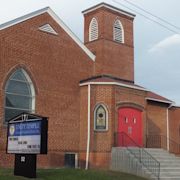Search results
temple: [noun] a building for religious practice: such as. either of two successive national sanctuaries in ancient Jerusalem. a building for Mormon sacred ordinances. the house of worship of Reform and some Conservative Jewish congregations.
The Temple in Jerusalem, or alternatively the Holy Temple ( Hebrew: בֵּית־הַמִּקְדָּשׁ, Modern: Bēt haMīqdaš, Tiberian: Bēṯ hamMīqdāš; Arabic: بيت المقدس, Bayt al-Maqdis ), refers to the two religious structures that served as the central places of worship for Israelites and Jews on the modern-day Temple ...
A Hindu temple, also known as Mandir, Devasthanam, or Koil, is a sacred place where Hindus worship and show their devotion to dieties through worship, sacrifice, and devotion. It is considered the house of the god to whom it is dedicated. [2] [3] The design, structure and symbolism of Hindu temples are deeply rooted in Vedic traditions, which ...
Mar 10, 2024 · The First Temple was constructed during the reign of David’s son, Solomon, and completed in 957 bce.Other sanctuaries retained their religious functions, however, until Josiah (reigned c. 640–609 bce) abolished them and established the Temple of Jerusalem as the only place of sacrifice in the Kingdom of Judah.. The First Temple was built as an abode for the Ark and as a place of assembly ...
Sep 2, 2009 · A Temple (from the Latin templum) is a structure usually built for the purpose of, and always dedicated to, religious or spiritual activities including prayer, meditation, sacrifice and worship.The templum was a sacred precinct defined by a priest (or augur) as the dwelling place of a god or gods.. The structure built at such a site was created to honor the Deus Loci (spirit) of a certain place.
Mar 31, 2024 · published on 31 March 2024. Temples have been raised in honor of a peoples’ deities since before recorded history as evidenced by sites now regarded as religious centers including Gobekli Tepe, Stonehenge, Newgrange, among many others. Temples met the needs of the people in providing them with a sacred space to commune with the Divine.
The root tem- in Greek and Latin denotes a “cutting” or intersection of two lines at right angles, “the point where the cardo and decumanus cross,” hence where the four regions come together, [15] every temple being carefully oriented to express “the idea of pre-established harmony between a celestial and a terrestrial image.”.





